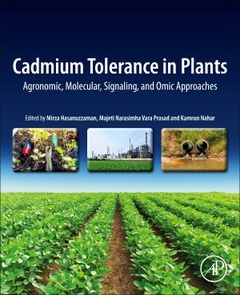Description
Cadmium Tolerance in Plants
Agronomic, Molecular, Signaling, and Omic Approaches
Coordinators: Hasanuzzaman Mirza, Prasad Majeti Narasimha Vara, Nahar Kamrun
Language: English
Subjects for Cadmium Tolerance in Plants:
Keywords
Abiotic stress; Aggravate; Agronomy; Alleviate; AM fungi; AMF; Antioxidant defense; Antioxidant machinery; Antioxidant signaling; Antioxidant system; Ascorbic acid; Bacteria; Binding sites; Bioremediation; Biotechnological tools; Cadmium phytotoxicity; Cadmium responsive proteome; Cadmium stress; Cadmium tolerance; Cadmium toxicity; Cadmium; Cd stress; Cd tolerance; Cd toxicity; Cd; Cellular markers; Cereals; Chelates; Chromosome aberration; Crop productivity; Crop; Cysteine; Cytotoxicity; Defense proteome; Dietary risk; Environmental threat; Fertilizer regulation; Food chain contamination; Genomics; Genotoxic stress; Genotypic variation; Global food security; Glutathione; GSH; Heavy metal excess; Heavy metal stress; Heavy metal; Heavy metals; Heavy-metal stress tolerance; HMs; Hyperaccumulators; Immobilization; Inorganic amendments; Irrigation management; Krebs cycle acids; MET; Metabolomics; Metal tolerance; Metal uptake; Metallothioneins; Mobilisation; Molecular mechanism; Molecular signaling; Mutants; Mycorrhizal colonization; Mycorrhizal symbiosis; Mycorrhizoremediation; Nutrients; Organic acids; Organic manure; Oxidative and genotoxic stress; Oxidative stress; Phosphate; Phytochelatins; Phytohormones; Phytoremediation; Phytotoxicity biomarkers; Phytotoxicity; Plant detoxification; Plant nutrients; Plant signaling; Plant species; Polyamines; Protective metabolites; Proteomics; QTL; Quality; Redox homeostasis; Redox status; Remediation; Rhizoremediation; ROS; Signaling pathways; Soil amendments; Soil contamination; Soil pollution; Soil remediation; Solubilisation; Sorghum; Stress; Sulfur metabolism; Thiols; Tillage management; Tolerance mechanism; Tolerance; Toxic metals; Transcription factors; Translocation; Wheat growth; Yield quality; Yield; Zeolites; Zinc
630 p. · 15x22.8 cm · Paperback
Description
/li>Contents
/li>Readership
/li>Biography
/li>Comment
/li>
2. Molecular mechanisms of the plant cadmium stress response
3. Recent advances in genomic and genetic approaches to enhance Cd tolerance in plants
4. Genetic control of metal uptake and sequestration in hyperaccumulating plants
5. Cadmium phytotoxicity – biomarkers
6. Understanding of Cadmium toxicity and tolerance in higher plants by proteomic approach
7. Biotechnological tools in remediation of cadmium toxicity
8. Novel technologies for developing cadmium tolerance
9. Putting the pieces together: Cadmium-induced oxidative stress and signaling in plants
10. Plant metallothioneins: diversification for cadmium handling
11. Agronomic management for cadmium stress mitigation
12. Inorganic amendments for the remediation of cadmium contaminated soils
13. Organic manures for cadmium tolerance and remediation
14. Cadmium induced toxicity in Sorghum bicolor- Alleviation by zinc and aggravation by phosphate
15. Role of organic acids in mitigating Cadmium toxicity in plants
16. Role of chitin and chitosan in mitigating cadmium toxicity in plants
17. Application of biosolids/biochar for cadmium minimization in crops
Dr. Prasad has served the Ministry of Environment, Forests and Climate Change, Government of India in various advisory committees on biodiversity conservation, ecosystem services, pollution control and abatement, environmental information systems and bioremediation of contaminated sites. He is an active visiting scientist in several international universities.
He is the editor, co-editor, or author of 17 books published by leading international publishers and 190 journal articles and 118 book chapters/conference proceedings. He has made outstanding contributions to the fields of bioremediation, bioresources, biomass energy sources, bioeconomy and to the broad field of environmental biotechnology, all of which are his main areas of expertise.
Dr. Kamrun Nahar, Department of Agricultural Botany, Faculty of Agriculture, Sher-e-Bangla Agricultural University, Dhaka, Bangladesh – She is well expert in the field of Plant Physiology, Ecology, Molecular Biology and Abiotic Stress Tolerance. Published 1o book chapters and more than 30 research articles.
- Provides data on mechanisms of cadmium tolerance at the cell, organ and whole plant level
- Covers several major approaches, molecular and agronomic, in addressing cadmium toxicity in plants and soil
- Offers real-world, application focused techniques
These books may interest you

Detoxification of Heavy Metals 210.99 €



